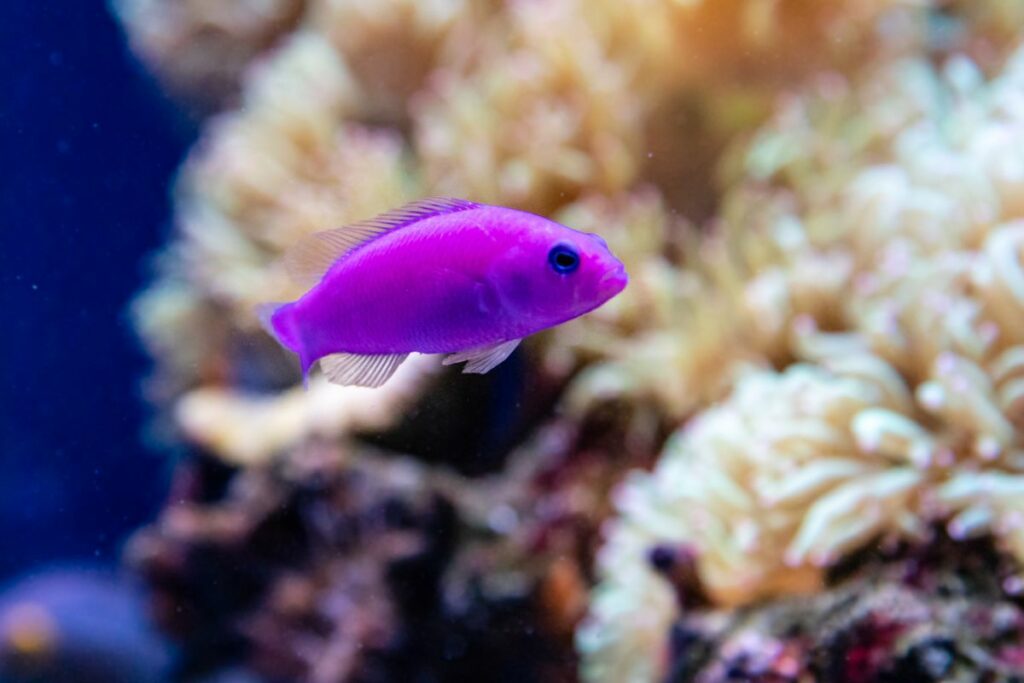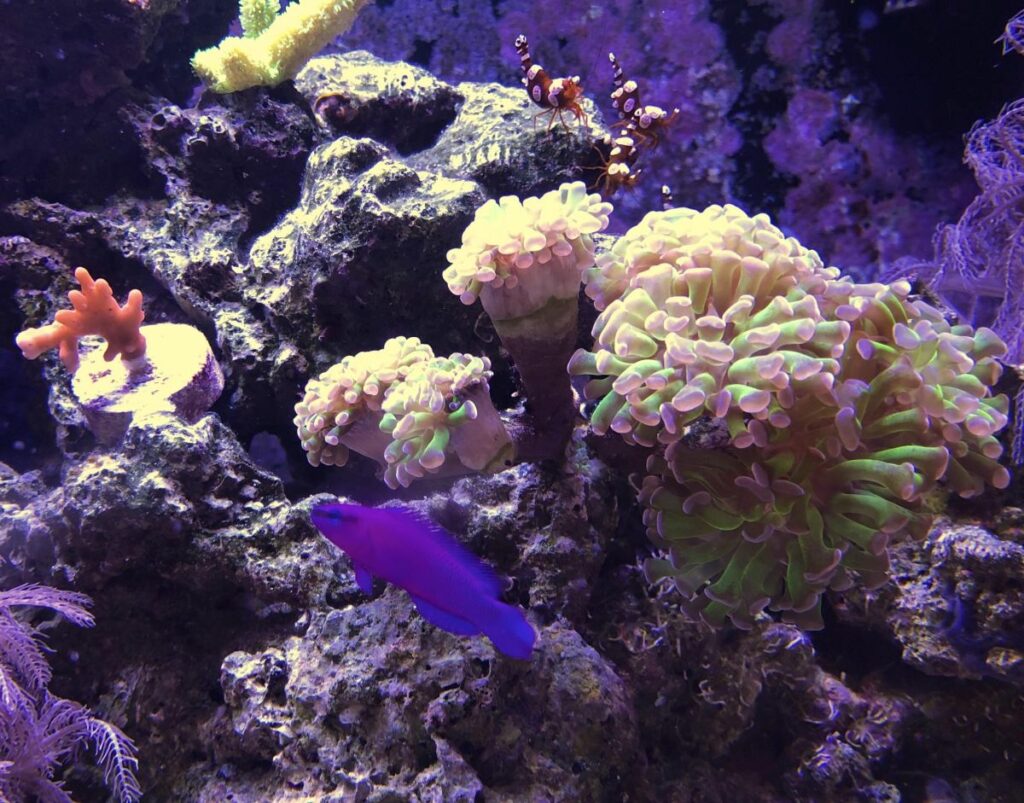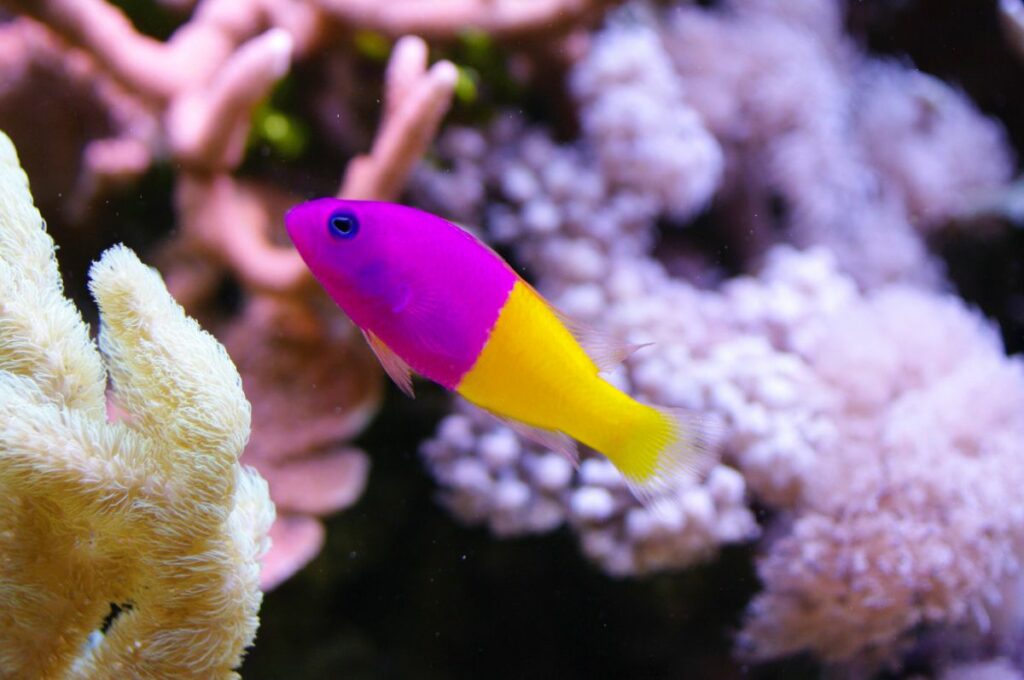Purple saltwater fish like magenta dottyback fish have a way of catching your attention. Even against the clashing colors of a coral reef, dottybacks stand out. Their bold and active disposition make them interesting community tank additions. But are dottybacks right for your fish tank?

What are Dottyback Fish?
Dottybacks make up the family Pseudochromidae. These are all tropical reef dwelling fish found in the Indo Pacific ocean.
Dottybacks are carnivorous fish that are small. 2 to 4 inches is normal, depending on the species. The green wolf eel (Congrogadus subducens) is one dottyback that will reach 18 inches.
Dottyback fish have a well earned reputation for being both hardy and aggressive. Which makes deciding to keep one a real challenge. We all want fish that are beautiful and durable.
Dottybacks will bully not only each other but their tank mates. Even larger fish aren’t safe from being chased and nipped by them. And whatever you do, don’t keep a dottyback alongside fish with similar color patterns.
The dottyback will treat it as a rival and attack it mercilessly. A bicolor dottyback (Pictichromis paccagnellae) will try to kill a royal gramma (Gramma loreto). Even though the royal gramma is a less aggressive fish that isn’t related at all.
Once you have a dottyback, getting it out of the tank may prove impossible without breaking it down. These fish are quick, small, and slim. They are able to hide in the smallest of crevices. So only buy a dottyback if you’re willing to put up with their outsized personalities.
- Common Names: Orchid Dottyback, Magenta Dottyback, Striped Dottyback, Indigo Dottyback, Bicolor Dottyback
- Scientific Name: family Pseudochromidae
- Origin: IndoPacific Ocean
- Length: 2 to 4 inches
- Tank Size: 20+ gallons
- Temperament: Semi-Aggressive to Aggressive; Territorial
- Ease of Care: Very Easy
Species Profile: Orchid Dottyback
Orchid dottyback fish are middle of the road in terms of temperament. They aren’t as aggressive as bicolor dottybacks (Pictichromis paccagnellae) or purple stripe dottybacks (Pseudochromis diadema). Yet they are much prettier than striped dottybacks.
Orchid dottybacks are so popular they are easy to find even as captive bred individuals. Captive bred fish are even hardier than wild caught specimens. They eat flakes without issue and will breed in captivity with little effort.
- Scientific Name: Pseudochromis fridmani
- Length: 3 inches
- Temperament: Semi-Aggressive
Species Profile: Striped Dottyback
If you want most of the pros of keeping a dottyback with few of the drawbacks the striped dottyback is the fish for you. It’s one of the least colorful members of the family. But it’s also mild tempered and won’t chase most tank mates.
You still want to avoid keeping them with any fish of a similar pattern. So bluestreak cleaner wrasses are out. Otherwise, striped dottybacks are excellent beginner dottybacks to keep.
- Scientific Name: Pseudochromis sankeyi
- Length: 3 inches
- Temperament: Peaceful to Semi-Aggressive
Dottyback Fish Care
Dotty back fish are some of the easiest marine fish to care for. They aren’t disease prone or picky eaters. Dottybacks need nothing more than plenty of space and the right tank mates.
Dottyback Tank Size

Since orchid dottyback fish are so small it is tempting to keep them in small tanks. 20 gallons is the minimum for an adult dottyback. But it’s not the best idea.
The smaller the tank, the more aggressive your dottyback will be towards its tank mates. Since dottybacks are so territorial, a small tank means less room for other fish to swim in. A 30 gallon tank gives everyone more breathing room and larger tanks are better still.
Water Conditions for Purple Pseudochromis
Saltwater fish have a reputation for being more difficult to care for than freshwater fish. There is some truth to this claim. The reason is that the ocean is such a stable environment compared to freshwater bodies of water.
In the ocean, changes happen over the course of thousands of years. While a river or lake may shift in weeks, days, or even hours. Saltwater fish don’t do well with sudden changes in salinity or ammonia. So the more stable you keep the environment, the better.
Dottybacks are one of those rare saltwater fish that are adaptable to change. Since beginner marine aquarists often struggle with maintaining specific parameters a dottyback is a great choice.
Ammonia and other nitrogenous waste levels should still remain at or close to 0 parts per million. But a dottyback will survive a rise in ammonia for a short time.
They prefer standard marine conditions when it comes to salinity. Your specific gravity should measure 1.020-1.025. Water temperatures of 73-80℉ are ideal for them.
You don’t need to track calcium, magnesium, and other elements unless you are keeping a dottyback in a reef tank. Any standard marine aquarium salt blend will contain enough of these elements for proper fish health.
I do recommend using a crushed coral substrate, however. Marine substrates keep the pH buffered towards alkalinity. A pH of 8.0-8.4 is required for dottyback fish.
Dottyback Tank Mates
Finding compatible fish is the hardest part about keeping a dotty back. Dottybacks are small but sometimes ferocious.
Their temperament depends on the species you have, the aquarium layout, its size, and the tank mates in question. Even a milder species like the orchid dottyback may turn mean if kept in a small 20 gallon tank with peaceful fish.
The more space you provide the easier it will be for dottyback tank mates to avoid their territory. Semi-aggressive to aggressive saltwater fish work best as tank mates.
Dwarf angelfish like the flame angelfish (Centropyge loricula) and coral beauty (Centropyge bispinosa) are different in color and shape. Plus they aren’t so easy to bully. Tangs and surgeonfish are also compatible since they will defend themselves if chased.
Peaceful midwater swimmers like Chromis sp. damselfish and anthias will avoid the areas dottybacks prefer. Clownfish paired with a sea anemone are also well defended from an aggressive dottyback.
Remember that while dottybacks are aggressive they are still small, slim fish. Don’t keep them with large tank mates. Lionfish, marine bettas, moray eels, and other predators will swallow an angry dottyback with one bite.
What Do Dottyback Fish Eat?

Dottybacks are carnivores that specialize in small invertebrates. Most prefer crustaceans like copepods and small shrimp. But they will also eat any worms, small crabs, and other prey in the wild.
Such a diet would be hard to provide in captivity. Several fish with a similar diet end up starving. But dottybacks are flexible and adapt to eating flakes and pellets with gusto.
Any formula you choose should still be rich in animal protein. With little in the way of plant based fillers or starch.
Fresh and frozen food should be offered several times per week. The extra fat, protein, and carotenoid pigments will enhance dottyback health and color alike. Brine shrimp, mysis shrimp, chopped shrimp, and diced clam are all acceptable.
As invertebrate hunters, dottybacks are a natural way of controlling bristle worm populations. Their size allows them to fit into small crevices and pluck bristle worms from their hiding places. Baby mantis shrimp are also on their menu.
Breeding Dottyback Orchid Fish
Breeding dottyback fish is both easy and difficult. Easy because once you have a pair they don’t need much in the way of special food or water conditions to spawn. And difficult because they are so aggressive towards each other.
Like many other marine fish, dottybacks are protogynous hermaphrodites. They don’t have both sexual organs at once, however. Dottyback fish will change sex depending on interspecies dynamics.
The most dominant (and largest) fish is a male. If two males fight and one loses again and again, it will shift sex to become female in response. Since smaller males lose more often, they become females. Otherwise they would not mate often since females prefer larger mates.
The easiest way to spawn dottybacks is to buy a mated pair. If you can’t find two that are already paired, you should try keeping a young pair in a large (30+ gallon) tank.
Offer plenty of hiding places for the eventual loser of these battles. They will fight until one fish is considered dominant. That fish will be the male and the other shifts to becoming a female.
Once the sexes are fixed they will often (not always) pair up. Even with a mated pair the male may still chase his mate at times but not to the death.
Conclusion
Dottyback fish are a challenge when it comes to managing their feisty tempers. But in every other respect they are excellent marine fish to keep. Dottybacks are affordable, beautiful, reef safe, and hardy. They stay small, are active swimmers, and even beginners have a chance at spawning them.
FAQs
Dottyback fish are considered reef safe fish. They feed on invertebrates in the wild but eat small crustaceans, not cnidarians. Dottybacks don’t eat corals, anemones, sponges, and other reef denizens.
If you are keeping a single dottyback or a mated pair a 20 gallon long is enough space. But if you want more fish then you need at least a 30 gallon tank. An even larger tank is better since these fish are aggressive and territorial.
Peaceful fish that are fast moving are a good match. Clownfish with an anemone to hide in are safe with a dottyback. As are other semi-aggressive reef dwellers like wrasses, tangs, angelfish, and surgeonfish. Don’t keep dottybacks with fish of a similar shape and color or they will be treated as rivals.

